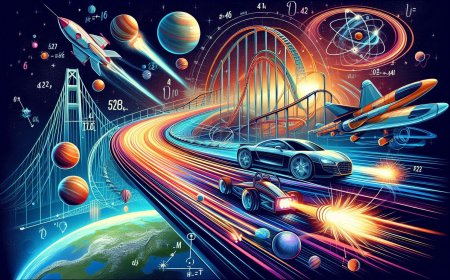Speed: The Essence of Motion in Physics
Explore the fundamental physics of speed, from everyday motion to cosmic velocities, as we dive into how speed affects objects, time, and energy. Learn about instantaneous and average speed, the cosmic constant of light speed, and practical applications in technology, transportation, and science.

In the realm of physics, speed stands as one of the most fundamental concepts, capturing the essence of how fast an object moves. But speed is more than just a measure of movement; it’s a window into the intricacies of motion, energy, and time. Whether it’s a car racing down the highway, a beam of light crossing vast cosmic distances, or particles zooming within a microscopic world, speed plays a pivotal role in shaping our understanding of both the physical and the cosmic scales.
What is Speed?
Simply put, speed is the rate at which an object covers distance. In mathematical terms, it is the distance traveled divided by the time it takes to travel that distance:

Measured in units like meters per second (m/s) or kilometers per hour (km/h), speed tells us how fast something moves but gives no indication of the direction of motion. In this way, speed differs from velocity, which includes both speed and direction.
Speed in Everyday Life
From commuting to the workplace to the speed of internet connections, speed influences our daily lives. For instance, the average car on a highway travels at speeds of 60-100 km/h, while a passenger jet moves at around 900 km/h. Each of these speeds reflects practical applications of physics, where transportation and efficiency rely on understanding and controlling speed.
Types of Speed: Instantaneous vs. Average
- Instantaneous Speed: This is the speed of an object at a particular moment in time. It’s what you see on a car's speedometer, reflecting how fast it’s moving in real time.
- Average Speed: Often, journeys don’t occur at a constant rate. Average speed is calculated by dividing the total distance traveled by the total time taken, regardless of variations in speed along the way. For instance, during a road trip with stops and starts, the average speed may differ greatly from the instantaneous speed.
Speed of Light: The Cosmic Constant
When discussing speed in physics, we can’t overlook the speed of light—one of the universe’s most significant constants. Traveling at approximately 299,792,458 meters per second (or about 300,000 km/s), light’s speed is not only astonishing but also sets the universal speed limit. According to Einstein’s theory of relativity, no object with mass can achieve or exceed the speed of light, making it a critical factor in the structure of space and time.
The implications of light speed go beyond just rapid movement; it forms the basis for understanding relativity. As objects approach this cosmic speed limit, they experience time dilation (slower passage of time) and length contraction (shortening of distance). Thus, the speed of light is not just a physical constant—it’s a bridge to understanding the very fabric of our universe.
Measuring Speed in Physics
Speed measurement can take many forms. Basic methods involve tools like speedometers for vehicles or radar guns used by law enforcement to gauge car speeds. In physics experiments, laser-based tools and high-speed cameras allow for precise speed measurement, even at microscopic or molecular scales.
Practical Applications of Speed
Speed finds applications across various scientific and engineering domains:
- Transportation: Engineering faster trains, planes, and cars requires a deep understanding of speed, along with the forces that come with increased velocities.
- Sports Science: In athletics, from sprinting to cycling, athletes aim to maximize speed. Understanding speed mechanics helps coaches and trainers enhance performance and safety.
- Communication Technology: In digital networks, speed often refers to the rate of data transfer. The evolution of internet speeds—from kilobytes per second to gigabits per second—illustrates advancements in technology that affect nearly every aspect of modern life.
Factors Influencing Speed
Several factors can affect the speed of an object:
- Force: According to Newton's Second Law, the greater the force applied to an object, the faster it accelerates, increasing its speed over time.
- Friction: Frictional forces, whether from air resistance, surface texture, or contact with other objects, slow down moving objects, reducing their speed.
- Mass: Heavier objects require more force to accelerate, which can limit the speed they achieve with a given amount of energy.
Why Speed Matters
Understanding speed is crucial for advancements in science and technology. It allows us to explore, control, and design systems that push the boundaries of what’s possible—from rockets that launch us to space to electric cars that move us sustainably across cities. In physics, speed isn’t just a measure of movement; it’s a key that opens doors to understanding how objects interact with energy, time, and space itself.
The Future of Speed
As our technological capabilities evolve, so does our pursuit of speed. With the development of hyperloops, hypersonic jets, and even interstellar probes, humanity pushes further into realms of high velocity. Each step forward provides new insights into physics, enabling us to challenge our limitations and redefine how fast we can go.
Conclusion
Speed, while seemingly simple, is a fundamental aspect of physics that underpins nearly every experience in our physical world. From a sprinter dashing toward the finish line to particles moving near the speed of light, speed captures the dynamics of motion, challenging us to think beyond mere movement and delve into the heart of energy, time, and distance. As we continue to push the boundaries of speed, we come closer to uncovering the deeper mysteries of our universe, with speed acting as our constant companion on this endless journey.
What's Your Reaction?


























